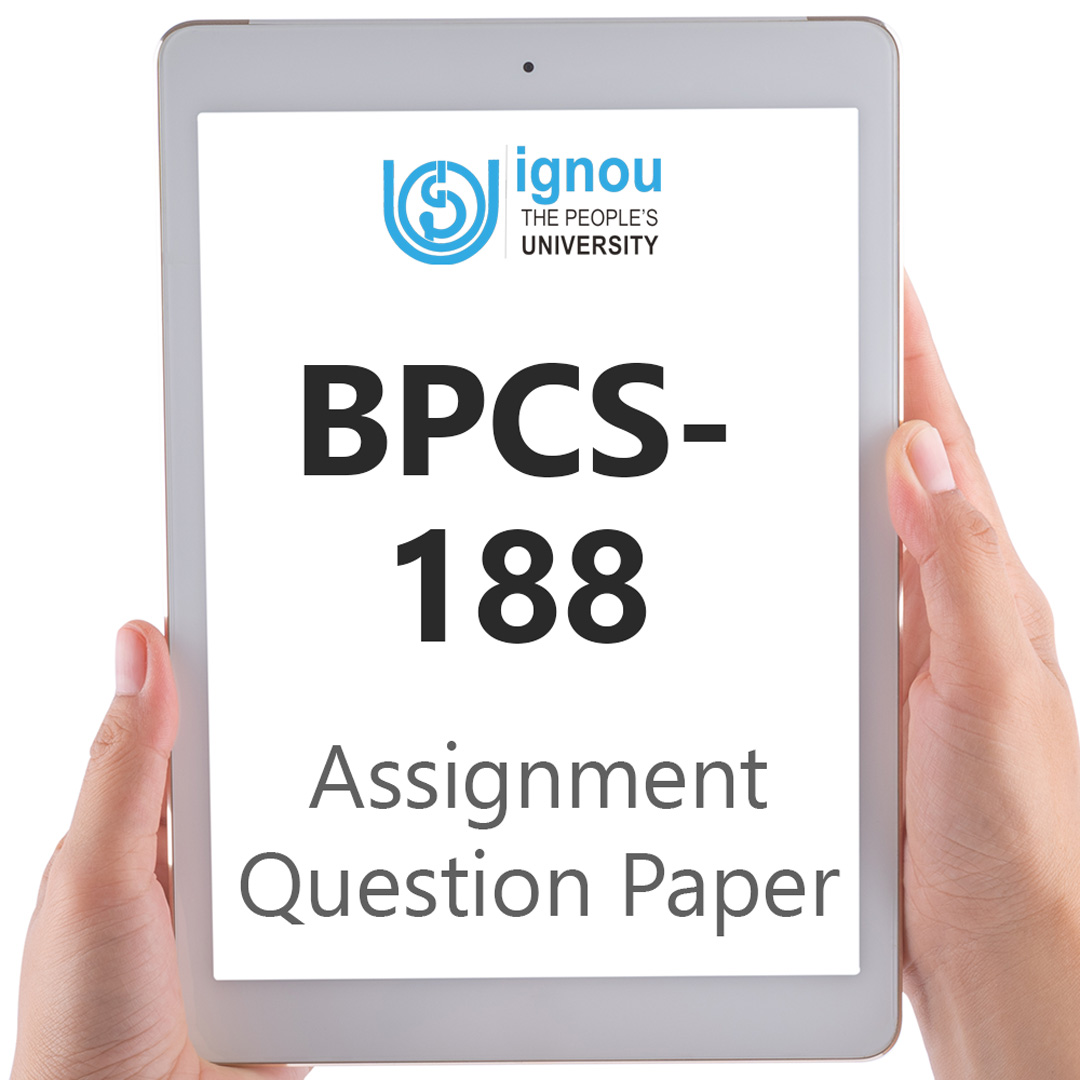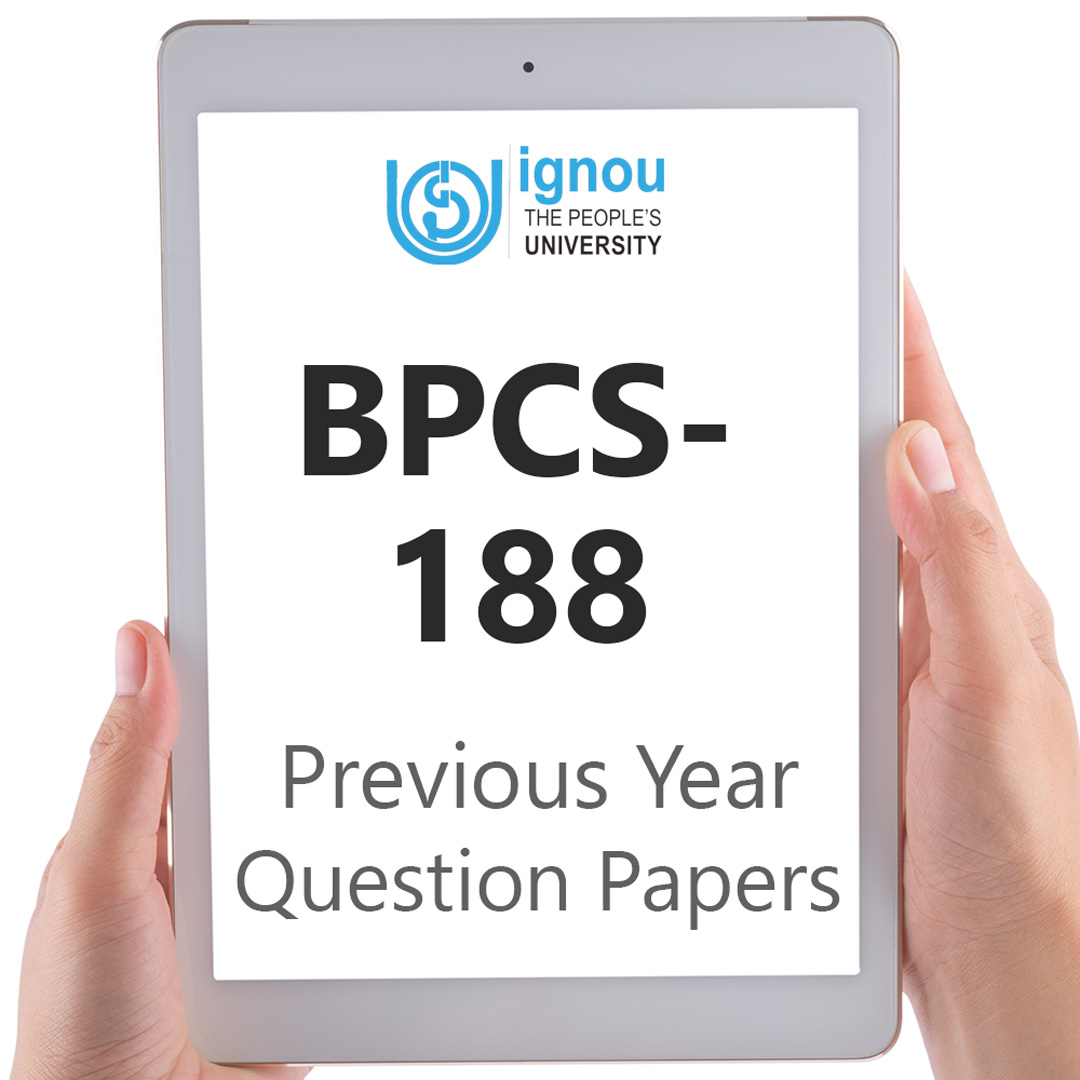If you are looking for BPCS-188 IGNOU Solved Assignment solution for the subject Application of Social Psychology, you have come to the right place. BPCS-188 solution on this page applies to 2022-23 session students studying in BAG, BSCG, BAECH, BAHIH, BAPSH, BAPCH, BAPAH, BASOH, BSCANH, BAEGH courses of IGNOU.
BPCS-188 Solved Assignment Solution by Gyaniversity
Assignment Code: BPCS-188/ Asst /TMA /2022-23
Course Code: BPCS-188
Assignment Name: Applications of Social Psychology
Year: 2022-2023
Verification Status: Verified by Professor
NOTE: All questions are compulsory.
Assignment One
Answer the following descriptive category questions in about 500 words each. Each question carries 20 marks. 3 x 20 = 60
Q1) Elucidate the applications of social psychology to the various social problems. (20)
Ans) The application of social psychology to various social problems are as follows:
Social Psychology in Legal System
In a society, there is much opportunity for interaction, and as people interact, attitudes, emotions, beliefs, and cognitions all have an impact on things like behaviour and judgement. These attitudes and ideas have a significant impact on the participants in the courtroom or legal system, including the judges, jurors, pleaders, attorneys, defendants, and witnesses. At the turn of the century, Hugo Munsterberg began to place trust in the veracity of eyewitness accounts.
He noted that people typically have a tendency to reconstruct events in ways that do not correspond to what actually happened based on his observations. He believed that as emotions have a big impact on a witness's memory, statements of what happened are frequently greatly altered or twisted by emotions like fear, worry, and rage, among others. Recently, there has been a push to improve the reliability of eyewitness testimony. Munsterberg developed a physiological tool to identify lying and also looked into the use of hypnosis as a way to improve the veracity of witness evidence. The focus of ongoing research in this area is both hypnosis and lie detection.
Health Psychology
The social and psychological facets of healthcare are mentioned. According to Gondola, some personality traits make a person more likely to get particular diseases. A rise in physical fitness results in a rise in psychological traits like inventiveness. Therefore, health psychology focuses on the psychological processes that influence the diagnosis, prognosis, and therapy of physical illness, according to Rogers.
Always preferable to avoid an illness than to treat it, prevention is always preferable to treatment. According to Kirscht, all health initiatives must take into account how each person views their readiness to heed medical advice. A health belief model was developed as a result of problem analysis. It implies that a person's health-related behaviour is predicted using his or her beliefs about health and the risk of illness.
Social Psychology and Work Setting
Business behaviour is influenced by social psychology as well as economic issues. Weber's theory of bureaucracy was developed without taking into account the interpersonal dynamics that exist in the workplace. Later Hawthorne tests showed that social elements, such as attention provided to the workers, enhanced worker productivity.
Social Psychology in Community and National Affairs
Social psychology is immensely helpful in human affairs, especially at the local, governmental, and global levels. As an illustration, community meetings are held to increase social awareness and inspire cooperation among members in order to achieve desired outcomes.
Social Problem in Military
The application of group dynamics research can also be made in relation to military organisations and job performance. It has been investigated how well social units like bomber crews and submarine crews perform in terms of leadership, group cohesion, and role connections. Although more regimented and strictly structured military organisations are essentially equivalent to industrial communities, the application of social psychological research to these organisations is essentially parallel to those in commerce and industry.
Social Psychology and Social Problems
Societal psychology addresses current, common social issues. Of course, it doesn't immediately offer solutions, but in many respects, it offers helpful direction for potential approaches to comprehending and addressing these issues.
Q2) Describe the various treatment and prevention of mental health problems. (20)
Ans) The treatment and prevention of mental health problems are as follows:
Psychotherapy
The therapeutic and effective treatment of mental health issues by a trained expert is known as psychotherapy. Psychotherapy aims to enhance human behaviour, ideas, and feelings, investigate a person's wellbeing, promote a positive outlook, uphold stronger connections, and resolve psychiatric issues. Psychotherapy is a lengthy form of treatment that can last for months or even years and is centred on developing a rapport between the client and the therapist. Psychotherapists use medicine and treatment to achieve rapid recovery. Exposure treatment, relaxation therapy, behaviour therapy, and primarily cognitive behavioural therapy are all used in psychotherapy.
Medication
Medication is a crucial sector that aids in the treatment of illnesses, infections, blood pressure regulation, pain relief, physical aches, and mental health issues. Psychiatric medications are constructed of synthetic chemicals that have an impact on the neurological system of the human brain, treating psychiatric disorders or mental health issues while lowering hospitalisation costs. Then, it might be concluded that many people have received treatment, rehabilitation, and deinstitutionalization without being admitted to any psychiatric hospitals. However, taking a high amount or doing so without consulting a medical professional can have harmful or contagious effects. It is stated that since combinations of common medications and somatic (psychiatric) medications have never been studied, harmful consequences from psychiatric medication, including heart failure or additive effects of brain damage, may happen.
Self Help Plan
Self-help is a strategy for self-improvement that enables someone to resume enjoying life. Self-help refers to strengthening personal qualities by putting into practise techniques that increase an individual's effectiveness. Every person pledges to modify their way of life in order to be happier and more content with themselves. Being compassionate on a mental and emotional level is crucial. With the aid of a self-help plan, a person may be able to assist in doing things like spending time in the shade of nature, residing in tranquil places like temples in order to nurture oneself, and spending quality time with family and friends in order to enhance one's strength. In a self-help plan, a person must avoid isolation, get enough sleep, get rid of negative ideas, and carry out all of their responsibilities.
Hospitalisation
When a person has a mental illness, hospitalisation is frequently necessary so that his or her entire health can be monitored, correctly diagnosed, and treated. Major depressive disorder, severe mental diseases, and other mental illnesses can be treated in psychiatric facilities on a temporary or permanent basis. Patients are admitted based on their erratic health, their involuntary commitment, and their voluntariness.
Community Based Treatment
People may hesitate to seek help because of the stigma associated with mental illnesses. Stigmatization by the public can affect prospects for the public and may have detrimental effects on finding and keeping a suitable job. According to research, internalising stigmas might cause someone to reflect unfavourable emotional responses, which lowers their quality of life. It makes an effort to reverse the prevalent avoidance of therapy in light of one's own experiences with mental illness. The other sort of mental illness care is community-based, which offers the resources needed to prevent drug use and self-harm. Additionally, it comprises counselling, relaxation treatment, support therapy, electroconvulsive therapy, and alternative medicine.
Q3) Explain the techniques used in the sampling method. (20)
Ans) The techniques used in the sampling method are Probability Sampling and Non- Probability Sampling.
Probability Sampling
It is a sampling method in which each member of the population has an equal chance of being chosen, and as this is accomplished by randomization, the method is also referred to as random sampling. This approach ensures that the procedure is entirely unbiased and randomised.
Simple Random Sampling: In this method, any unit, element, or person in the population has an equal chance of being chosen. When the researcher is not already familiar with the target demographic, it is used. Every unit has an equal chance of being chosen using this method, and the researcher's preferences or prejudice are not present in the selection process. The entire method is based on chance, giving each unit an equal chance, and no unit is selected based on the researcher's own preferences or whims.
Stratified Sampling: This method combines intentional sampling with random sampling. We first divide the entire population into categories based on how homogeneous they are, and then we select components from these subsets using random sampling. Therefore, this method of sampling is mixed. When the population can be broken down into groups based on shared traits, this technique can be used. These strata are created according to the unique characteristics of a group, and from these strata, units are chosen at random.
Cluster sampling is the process of dividing the entire population into clusters or sections, and then randomly selecting sections from each cluster or section. An entire cluster's units or members are surveyed. Age, gender, geographic location, and other factors can be used to identify these clusters.
Systematic Sample: With the exception of the initial element, we select the items in this sort of sampling methodically rather than at random. These components are picked at regular intervals in the population. Each of these elements receives an equal chance of being selected during the initial sequencing of all these elements.
Non- Probability Sampling
The sampling method is the only one that is independent of randomization. It relies on the researcher's ability to select the components of a sample. All elements or units of the population may not be represented equally since the outcome of this technique may be biased.
Convenience Sample: In this sampling method, the investigator chooses the study's components or items based on their convenience. There is no effort to gather data in accordance with a plan or procedure. Tourists employ this strategy when they are on the road. They interact with a small number of people they meet, conduct business with them, and then generalise this perception to the entire population of the nation or state. This strategy has no scientific validity and is known as a "hit or miss method." Because of this, some of the travel writing done by these people is excessive.
Deliberate sampling is another name for purposeful sampling. This approach gives the researcher entire freedom to select the sample according to his or her preferences. From the complete data set, some objects are picked and evaluated. The investigator is completely free to select any item that, in his or her opinion, will adequately reflect the full set of facts or the entire population. When the data are not diverse and the investigator is familiar with different aspects of the issue, they will use this straightforward sampling strategy. Despite being intentional, this strategy indicates that the elements that best represent the total population will be chosen. It does not imply a random selection.
Referral/Snowball Sampling: This sampling technique is used by the researcher when s/he has no prior knowledge of the population. The researcher chooses one element or person and asks him/her for a reference or recommendation of other people whose characteristics s/he may describe to suit the needs of the sample. The reason this is known as a "snowball" technique is because as more recommendations come in, the sample size keeps expanding.
Assignment Two
Answer the following short category questions in about 100 words each. Each question carries 5 marks. 8 x 5 = 40
Q4) Biopsychosocial Model
Ans) George Engel first proposed the notion of the biopsychosocial model in 1977. It contends that in addition to biological aspects, psychological and social factors should also be taken into account in order to comprehend a person's medical state.
Bio (physiological pathology)
Psycho (thoughts emotions and behaviours such as psychological distress, fear/avoidance beliefs, current coping methods and attribution)
Social (socio-economical, socio-environmental, and cultural factors such as work issues, family circumstances and benefits/economics)
This concept, which holds that the pain is a psychophysiological behaviour pattern that cannot be solely attributed to biological, psychological, or social variables, is frequently used to describe chronic pain. There are proposals that psychological counselling be included in physiotherapy in order to address every aspect of the experience of chronic pain.
Q5) Diagnosis of Mental Health Problems
Ans) Diagnosis of mental health problems can be done by the following ways:
Diagnostic Evaluation: Psychologists and psychiatric professionals are able to collect patient histories, examine symptoms, assess health status, and/or pinpoint issues that may be contributing to symptoms.
Psychological Tests: Screening is an essential stage in the diagnosis of disorders since it helps to spot the early warning signs and symptoms of mental health issues. The psychological/psychometric test aids in the identification of such issues. A psychometric test, often known as a psychological test, may contain measures of cognition, IQ, personality, aptitude, and other factors.
Psychological Interventions: After a psychological issue is identified, psychologists and psychiatrists work to improve their patients' mental health situations by using therapies and medicines, respectively.
Q6) Self-Perception and their Academic Consequences
Ans) In relation to the development of attitude, the idea of self-perception was introduced. According to the hypothesis, people form their views toward other people without knowing about their innermost feelings, moods, or behaviours.
Mental health and academic consequences are intertwined. The healthiness of psychological, emotional, and social situations is also known as mental health. It has an impact on how they act, think, and react. Depending on their performance levels, prior suspension letter rates, and other factors that have an impact on the compliance and implementation of policy, schools may respond to district demands for many of the repercussions of academic failure. The focus of the school should be on determining the best ways to advance education, create a powerful and secure school environment, and produce better work. It might lead to worse academic results, which would be detrimental to the school's or its financial situation. An important factor in reducing academic failure is the pattern of attendance and performance in the classroom, schools, grade, and at the individual level.
Q7) Diversity.
Ans) The diversity within intergroup relations and culture in the community are:
Cultural Diversity: One of the key ideas on which we might concentrate in this case is cultural diversity. Shared ideals that serve as a way of life might be characterised as culture. Through socialisation and enculturation, culture is socially transmitted. Therefore, culture is a prominent context for the majority of the behaviours that can be understood in a context. Cultural diversity results from the mixing of people from different cultures for a variety of reasons, such as migration for employment and education, because of globalisation, and so on.
Intergroup Relations: Intergroup relations describes how members of different social groupings view and communicate with persons from other groups. Prejudice is a negative attitude that is based on belonging to a group, whereas discrimination is behaviour that is directed towards other people because they fall under a particular category. The intergroup relationships may suffer as a result of this.
Q8) Social Psychology and Environment
Ans) Environmental psychology's interdisciplinary approach makes it possible for us to comprehend how behaviour and environment interact. It is well known that humans are naturally sensitive and aware of their surroundings. The environment is impacted by people in many different ways. Pollution, global warming, and climate change are three of the main environmental negative effects. The three R's — Reduce, Reuse, Recycle — and preserving and protecting natural resources are some of the beneficial human behaviours that are practised today due to increased understanding. In order to fulfil the objectives of sustainable development and human development, it strives to research the relationships between the environment and the state of the human situation and to improve environmental protection consciousness and behaviours.
Q9) Differences between Basic and Applied Psychology
Ans). The differences between basic and Applied Psychology are as follows:
Q10) Relationship between Applied Social Psychology and other Social Sciences
Ans).The relationship between Applied Social Psychology and other Social Sciences are as follows:
Basic social psychology and applied social psychology both focus on developing theories to explain social phenomena and putting those theories into practise to address behavioural problems and concerns.
Sociology and applied social psychology: In applied social psychology, psychological theories and principles are applied to societal settings. It focuses on a person's behaviour patterns in connection to their social environment.
Applied social psychology is tied to physiological processes, according to the field of physiological psychology. Human behaviour is a physiological response to the current physical and social environment, and physiological psychology makes an effort to understand the nature of all types of physiological processes, or the operations of all body organs.
Q11) Survey Research
Ans) The descriptive research approach, which is one of the quantitative techniques used for studying bigger samples, is a non-experimental technique used in survey research. In survey research, the researcher gathers information via interviews or standardised questionnaires that are given to a sample of respondents drawn from the general community. One type of applied social research that might aid with data collecting through both direct and indirect observation is survey research. Survey research is a method used by applied social psychologists to explore variations between individuals and groups in terms of feelings, attitudes, and behaviours.






